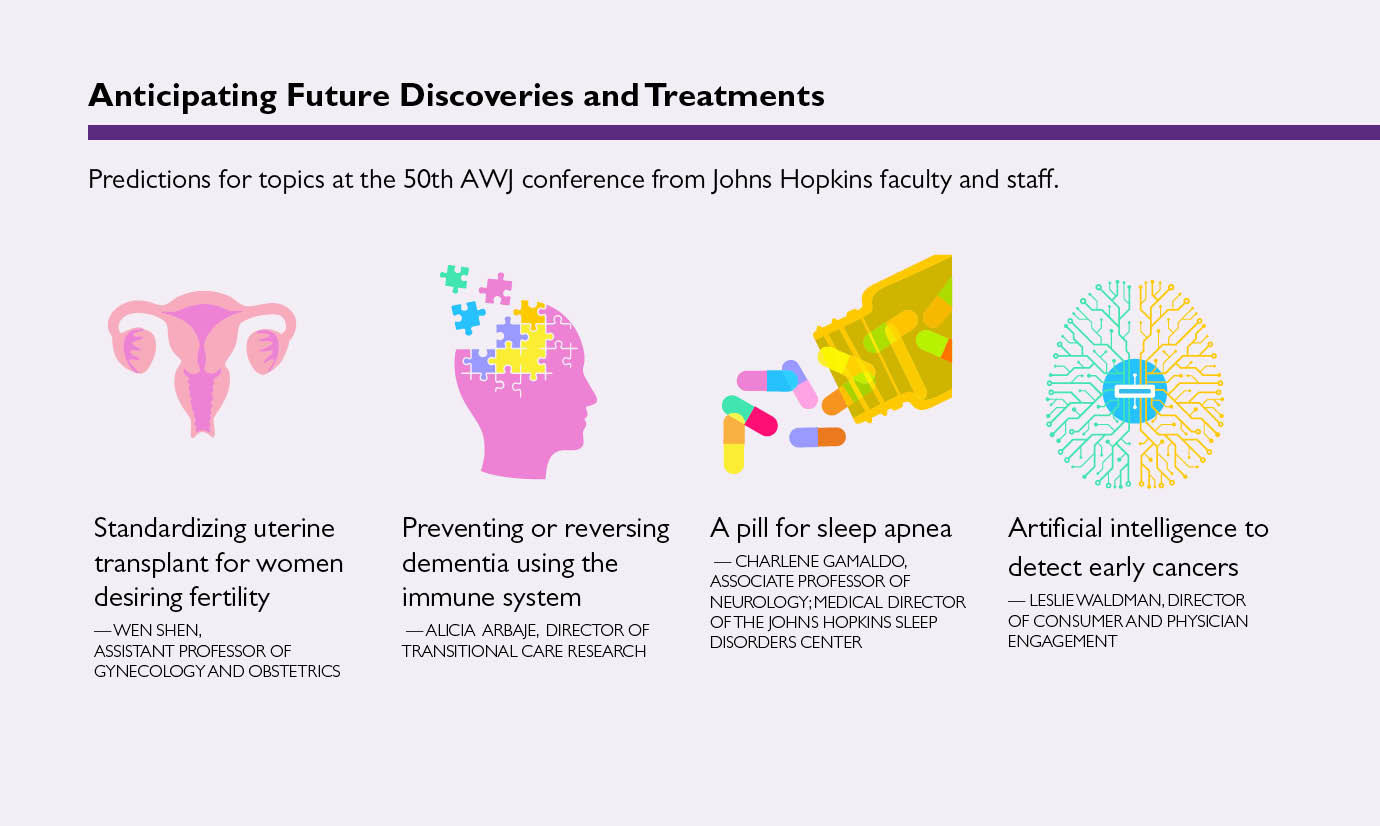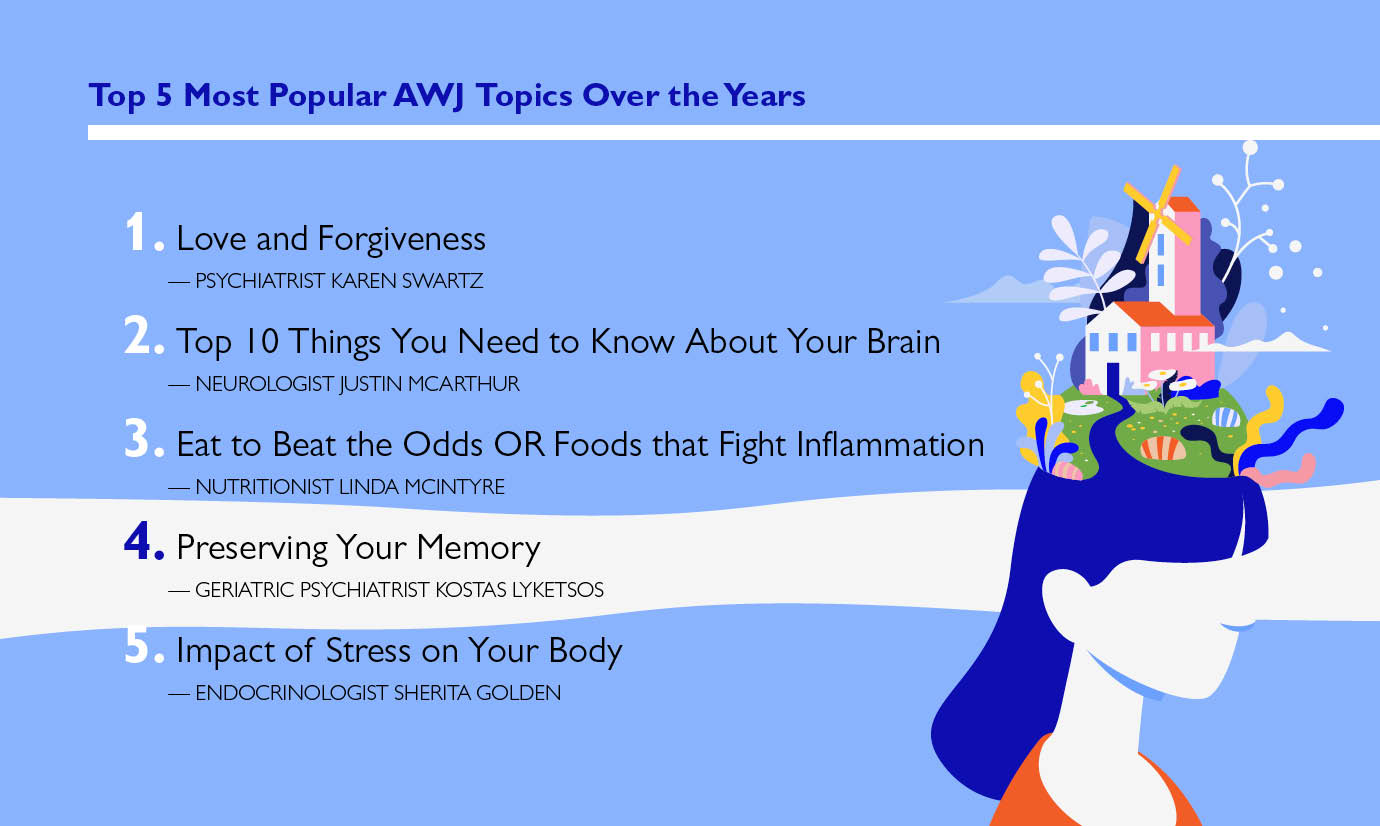When A Woman’s Journey (AWJ) debuted in 1995, researchers were beginning to understand more about the potential for targeted cancer treatment and antiviral therapy to treat HIV. The accelerating pace of discovery unveiled advances that once seemed inconceivable, such as DNA testing, robotics and specialized technology to detect tumors.
In addition, the concept of “wellness” — how to improve one’s odds for a longer, healthier life — was beginning to enter medical news. At that time, the first of the Baby Boomers, born in 1946, were nearing menopause. Sessions on sexuality, migraines and breast reconstruction drew great interest at the inaugural women’s health event.
Now, 25 years later, more information than ever is emerging about women’s health issues through online news and social media.
“Some people might argue that a conference focused on women has run its course, but at the rate medicine is changing, AWJ is more relevant than ever to women as they age,” says Leslie Waldman, director of consumer and physician engagement, who has orchestrated the annual fall event since its inception.
This fall’s 24-session symposium takes place on Saturday, Nov. 23, at the Hilton Baltimore. It’s expected to draw about 800 participants — yes, that includes a few men — from Maryland and as many as 19 other states.
What is more, AWJ has spawned satellite events in eight locations around the country and internationally. The AWJ team also provides speakers at events and forums for major businesses, such as Brown Advisory, an investment management firm.
Some of the offerings this year look at how to lower risk for cardiac disease, the causes and types of osteoarthritis, and the impact that difficult relationships can have on health.
The idea for AWJ originated with cancer survivors Mollye Block and Harriet Legum. (Legum was treated at The Johns Hopkins Hospital; Block was living in Boston, where she was treated at that time.) They were eager to empower women to make informed health care decisions for themselves and loved ones. Legum continues to chair the conference, along with Kelly Geer Ripken (since 2015), founder of the Kelly Geer Ripken Thyroid Program at Hopkins.
The 650 women who attended the inaugural conference 25 years ago craved information that could help inform decisions about their own and their families’ physical and emotional well-being. They still do.
But there’s another reason women keep coming back, says Waldman: camaraderie. “Mothers, daughters, sisters and friends reunite while learning about the latest advances in health.”
A Targeted Approach to Choosing Topics
Initially, topics attracting the greatest interest included hormone replacement therapy, heart disease, cosmetic surgery and depression.
Over time, topics such as mindfulness, inflammation, healthy aging and insights into how memory works have acquired an audience, says Waldman, while others, like the impact of the environment on health, continue to be programmed every year.
Those choices are far from random. Waldman explains that the ultimate selection of subject matter and speakers is guided by input from faculty and by consumer surveys.
“We continue to find out what’s on women’s minds and identify experts to address those issues,” she says. The conference not only connects attendees to physicians, but also promotes Johns Hopkins Medicine’s educational mission.

Making Sense of Confusing Health Care Trends and Treatments
The proliferation of information on women’s health can be inaccurate as well as confusing. In 1995, for instance, many women at AWJ learned about the perceived benefits of hormone replacement therapy (HRT) that promised to relieve bothersome menopause-related symptoms, such as hot flashes and night sweats, while perhaps boosting heart health.
By 2000, however, this treatment had become controversial when two seminal studies found that HRT increased the risk for heart attacks and breast cancer in study participants. Women trying to reduce menopause symptoms began choosing other FDA-approved therapies, such as estradiol oral tablets and natural progesterone, according to gynecologist and AWJ speaker Wen Shen.
The history of HRT represents the often-shifting nature of health care recommendations, says Waldman, and underscores why it’s so important to update women on new medical discoveries and treatments.
The Push for More Diversity
In the early years of AWJ, most of the women who attended were white. That’s changing, says Waldman, in part because there are more women of color on the consumer and faculty advisory committees.
Endocrinologist Sherita Golden, recently appointed Johns Hopkins Medicine vice president and chief diversity officer of Johns Hopkins Medicine, says sessions have focused on health disparities over the years, but not consistently. Now, she notes, AWJ always covers chronic disease issues — for example, diabetes, cardiovascular conditions and kidney ailments — that disproportionately affect women of color.
Mortality rates remain stubbornly high in women of color from all backgrounds. Golden says AWJ outreach to this population continues to expand, and she hopes to raise awareness about the conference at predominantly black churches and sororities.
In recent years, AWJ has targeted Kidney disease, health disparities and mental health in women of color. This year, oncologist and epidemiologist Otis Brawley will speak about diagnosing and treating cancer in women of color.

Why Faculty Members Keep Coming Back
Over the past quarter-century, more than 500 faculty members have spoken at AWJ. Many, like neurologist Justin McArthur, now appear annually.
The neurologist-in-chief of The Johns Hopkins Hospital says he appreciates AWJ because “it’s a great opportunity to speak to lay audiences about some of the myths and important things to know about brain health.”
He says that the most common concern he hears is: “What can you do to keep your mind sharp as you age?”
He answers, “Quite simply, #1 is exercise.”
McArthur says he also enjoys meeting people informally. “At work, we sometimes get too focused on data and new treatments and don’t spend enough time thinking about what’s on patients’ minds.”
Longtime AWJ speaker psychiatrist Karen Swartz, recently named chair of the AWJ Faculty Advisory Committee, says she gets as much out of the experience as attendees do. Her sessions on forgiveness — how to move past personal grudges that harm relationships — and on depression and suicide are highly ranked among AWJ participants.
Some of her insights on forgiveness and caregiver stress, she says, have come from audience reactions at AWJ. She’s struck by how, with time, the questions participants ask about depression and relationships have become more personal.
“We are in rarified air here at Hopkins with our colleagues,” she says. “There’s nothing like being in the community and having someone ask you a question. Because you’re not their doctor, they feel comfortable telling you what they are really worried about.”
